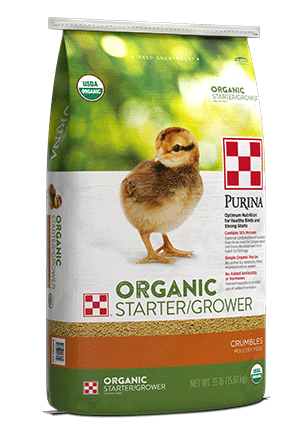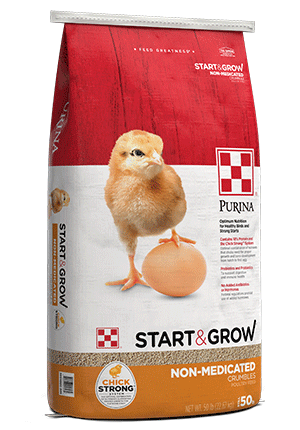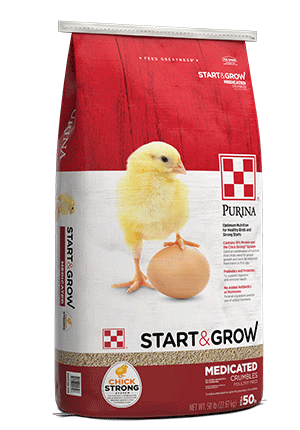
Hatching Eggs at Home: A 21-Day Guide for Baby Chicks
Starting a Flock : Considering Chickens
Starting a Flock : Caring for Chicks

Hatching eggs at home can be a fun project for those looking to grow their backyard flocks. Incubating chicken eggs is a 21-day process and requires an egg incubator to help control temperature, humidity and egg turning. To help baby chicks start strong once they’ve hatched, feed a complete Purina® chick starter feed from hatch until week 18, or when the first egg arrives.
Incubating eggs is a fun, 21-day project that can be successful with careful attention and a few special pieces of equipment. With care, vigilance and planning, you will be able to hatch baby chicks that grow up to become part of your backyard flock.
Eggs sold in grocery stores are not fertile; therefore, they will not grow into baby chicks if placed in an incubator. Fertilized eggs usually need to be ordered from a hatchery or from poultry farmers with roosters in their flocks. Either way, make sure your fertile eggs are coming from a National Poultry Improvement Plan (NPIP)-certified flock to help reduce the risk of disease.
Prior to incubation, a fertilized egg can be stored for a maximum of 7 days in a cool room kept at a steady 55-60 degrees Fahrenheit (not in the refrigerator – it’s too cold!). Once the fertilized eggs are placed in the warm incubator, they may develop over the course of 21 days, with the proper incubator set-up and care.
Before your baby chicks hatch, be sure to stock up on chick starter feed. A newly hatched chick will need free-choice access to complete feed immediately once they hatch and are placed in the brooder. Choosing a chick starter feed depends on your flock goals and if your chicks have been vaccinated for coccidiosis. Whether you purchase chicks from a local Purina retailer or are incubating eggs at home, you can start them Flock Strong® with a Purina® chick starter feed, such as Purina® Start & Grow®, Purina® Start & Grow® Medicated or Purina® Organic Starter-Grower.
Prepare the incubator about one week prior to the arrival of fertilized eggs. Wash it with a 10 percent bleach solution, followed by warm soapy water and a thorough rinse to ensure you’re starting with a sanitized environment. Once the incubator is clean and dry, turn it on and check to be sure a constant temperature and humidity level will be maintained. Then, place the incubator in an area where ambient temperatures are steady, with no risk of draft.
Temperature and humidity inside the incubator are critical factors for successfully hatching eggs. Suggested guidelines are as follows:
Plan to set a minimum of six eggs at one time. Setting fewer eggs, especially if the eggs were shipped, often results in one or no hatchlings. The number of chicks that hatch together is especially important for the newborn chicks because chickens are flock animals and need companions to be happy. Place the eggs in the egg tray of the incubator, with the larger end facing up and the narrow end facing down in the incubator. Set the temperature to 100.5 degrees Fahrenheit with 50-55 percent humidity.
Eggs must be physically turned to prevent the developing chick from sticking to the shell. More scientifically, the embryo should be resting on top of the yolk. The yolk tends to float upward, on top of the albumen (egg white) towards the shell if the egg is not turned. As a result, the developing embryo can be squeezed between the yolk and the shell, causing potentially fatal damage. By turning the eggs, the yolk turns within the albumin, once again moving the yolk away from the shell and making it safe for the embryo on top until it is time to turn again.
Eggs will need to be turned a minimum of 3 times per day, and 5 times is even better. If you are turning the eggs manually, it is advised to gently make a mark with a pencil (never a pen!) that will help you keep track of which eggs have been turned. If you have an automatic incubator, it should turn the eggs for you and will eliminate the need to repeatedly open the incubator (check the user’s manual).
Be sure to wash your hands or wear clean gloves before you touch the eggs to prevent the transfer of skin oils or germs to the developing chick.
Candling is the act of simply shining a light through an egg. White and light-colored shells are the easiest to candle, while darker shells will require a brighter light. The simplest way to candle an egg is with a basic flashlight, but there are specialized pieces of equipment designed specifically for the job. Do not keep the egg out of the incubator for more than 5-10 minutes, and don’t candle the eggs all at once. To allow the eggs to stay inside the incubator, plan to candle a few at a time.
To understand what you are looking for while candling eggs, read the following description from extension.com:
When the big day comes, let the chick hatch on its own. Do not attempt to help. Blood vessels that haven’t dried up yet may still attach the shell to the chick, and prematurely pulling of the shell can cause excessive, potentially fatal, bleeding. A chick can take up to 24 hours to completely hatch, although 5-7 hours is more common.
The peeping of the new baby chicks will encourage unhatched eggs to also start hatching. When the chicks have all hatched, the incubator temperature can be lowered to 95o Fahrenheit. Once the chicks have dried, they can be moved into the brooder, which should already be up and running with a temperature of 90-95o Fahrenheit. Food and water should be in place as well.
If there are still unhatched eggs at day 21, don’t despair. It is possible that timing or temperature went slightly awry, so give the eggs until Day 23. Candle any unhatched eggs to see if they are still alive before discarding them.
Keep in mind that when hatching eggs, you will likely end up with roosters. There is a 50/50 chance that a chick will be born a rooster. There is no good way to determine if a male or female chick is developing inside an egg. Some town ordinances do not allow backyard roosters, so have a plan for re-homing a rooster if you can’t keep him.
If you decide to keep a rooster, it is suggested to only have one. In addition, one rooster per 10 hens is typical for continued breeding. Any less than that can put hens at risk for overbreeding and injury.
Hatching eggs can be a very rewarding experience with proper planning and equipment. Remember to test all equipment before fertilized eggs arrive and set up the brooder as hatch day approaches.
Keep a watchful eye on temperature and humidity inside the incubator and invite friends and family over to watch the hatch. Everyone will be enthralled! Best of all, enjoy the new flock members you have had the privilege of raising from birth.
They’ve hatched! Here’s what to do once your baby chicks arrive.
Incubating eggs is a fun, 21-day project that can be successful with careful attention and a few special pieces of equipment. With care, vigilance and planning, you will be able to hatch baby chicks that grow up to become part of your backyard flock.
Keep reading for a step-by-step guide to hatching eggs at home:
Prior to incubating chicken eggs: Secure fertile eggs and chick starter feed
The first thing you’ll need to hatch chicks is, of course, eggs. For hatching to occur, the eggs must be fertile. Fertile eggs can be collected from hens who are housed with a rooster.Eggs sold in grocery stores are not fertile; therefore, they will not grow into baby chicks if placed in an incubator. Fertilized eggs usually need to be ordered from a hatchery or from poultry farmers with roosters in their flocks. Either way, make sure your fertile eggs are coming from a National Poultry Improvement Plan (NPIP)-certified flock to help reduce the risk of disease.
Prior to incubation, a fertilized egg can be stored for a maximum of 7 days in a cool room kept at a steady 55-60 degrees Fahrenheit (not in the refrigerator – it’s too cold!). Once the fertilized eggs are placed in the warm incubator, they may develop over the course of 21 days, with the proper incubator set-up and care.
Before your baby chicks hatch, be sure to stock up on chick starter feed. A newly hatched chick will need free-choice access to complete feed immediately once they hatch and are placed in the brooder. Choosing a chick starter feed depends on your flock goals and if your chicks have been vaccinated for coccidiosis. Whether you purchase chicks from a local Purina retailer or are incubating eggs at home, you can start them Flock Strong® with a Purina® chick starter feed, such as Purina® Start & Grow®, Purina® Start & Grow® Medicated or Purina® Organic Starter-Grower.
How to set up the egg incubator
Fertile eggs can be hatched by using an egg incubator. An incubator is an enclosed structure with a fan and heater to keep eggs warm during the 21-day incubation period. When determining which incubator to purchase, we recommend using an incubator with some automatic features, such as egg turning (which is critical to chick development and to keep the chick from sticking to the inside surface of the shell) and a fan to facilitate even heat distribution.Prepare the incubator about one week prior to the arrival of fertilized eggs. Wash it with a 10 percent bleach solution, followed by warm soapy water and a thorough rinse to ensure you’re starting with a sanitized environment. Once the incubator is clean and dry, turn it on and check to be sure a constant temperature and humidity level will be maintained. Then, place the incubator in an area where ambient temperatures are steady, with no risk of draft.
Temperature and humidity inside the incubator are critical factors for successfully hatching eggs. Suggested guidelines are as follows:
- Optimum temperature: 100.5 degrees Fahrenheit
- Temperature range: 99-102 degrees Fahrenheit
- Don’t let temperature drop below 99 degrees Fahrenheit
- Do not allow temps of 102 degrees Fahrenheit to last more than a few hours
- Double-check the incubator’s thermometer with a medical thermometer placed nearby to ensure the gauge is working properly.
- Relative humidity, day 1-17: 50-55 percent
- Equivalent to a wet bulb temperature of 85-87 degrees Fahrenheit
- Keep water channels in the incubator full to facilitate proper humidity
- Relative humidity, day 18-21: On day 18, raise the relative humidity to 70 percent
- Use a hygrometer to ensure humidity levels are correct throughout the incubation period
- Only open the incubator when necessary – doing so can let heat and humidity escape and can affect the success of the hatch.
- Increase ventilation as embryos grow bigger, especially from days 18-21.
Day 1: Setting eggs
Once you have the incubator set-up and have analyzed the settings to ensure accuracy, you are ready to place the eggs inside the incubator. This process is called “setting the eggs.”Plan to set a minimum of six eggs at one time. Setting fewer eggs, especially if the eggs were shipped, often results in one or no hatchlings. The number of chicks that hatch together is especially important for the newborn chicks because chickens are flock animals and need companions to be happy. Place the eggs in the egg tray of the incubator, with the larger end facing up and the narrow end facing down in the incubator. Set the temperature to 100.5 degrees Fahrenheit with 50-55 percent humidity.
Day 1-18: Turning the eggs
After setting the eggs, the incubation process begins. An important part of this process is turning, or rotating, the eggs.Eggs must be physically turned to prevent the developing chick from sticking to the shell. More scientifically, the embryo should be resting on top of the yolk. The yolk tends to float upward, on top of the albumen (egg white) towards the shell if the egg is not turned. As a result, the developing embryo can be squeezed between the yolk and the shell, causing potentially fatal damage. By turning the eggs, the yolk turns within the albumin, once again moving the yolk away from the shell and making it safe for the embryo on top until it is time to turn again.
Eggs will need to be turned a minimum of 3 times per day, and 5 times is even better. If you are turning the eggs manually, it is advised to gently make a mark with a pencil (never a pen!) that will help you keep track of which eggs have been turned. If you have an automatic incubator, it should turn the eggs for you and will eliminate the need to repeatedly open the incubator (check the user’s manual).
Be sure to wash your hands or wear clean gloves before you touch the eggs to prevent the transfer of skin oils or germs to the developing chick.
Days 7-10: Candling eggs
Towards the middle of the incubation period at 7 to 10 days, eggs can be candled to determine if the embryos are growing properly.Candling is the act of simply shining a light through an egg. White and light-colored shells are the easiest to candle, while darker shells will require a brighter light. The simplest way to candle an egg is with a basic flashlight, but there are specialized pieces of equipment designed specifically for the job. Do not keep the egg out of the incubator for more than 5-10 minutes, and don’t candle the eggs all at once. To allow the eggs to stay inside the incubator, plan to candle a few at a time.
To understand what you are looking for while candling eggs, read the following description from extension.com:
- If the inside of the egg is clear - that is, free from visible structures or dark areas - the egg is infertile, or the embryo died very early. Remove this egg from the incubator.
- If a ring of red is visible within the egg, there was an embryo at some point, but it has died. Remove this egg from the incubator.
- If you can see blood vessels within the egg, there is a live embryo inside. Blood vessels in chicken eggs are normally observable within 7 to 10 days of an egg's incubation. By 18 days of incubation, the embryo takes up most of the egg and appears as a dark area within the egg. You can sometimes see movement inside the egg.
Days 18-21: Pre-hatching
By day 18, the embryo has developed into a chick and will take up most of the space in the egg. The chick is preparing to hatch. You can do a few things to best help the baby chick prepare:- Stop egg-turning at day 18 with the larger end of the egg facing up. At this point, the chick will position itself for hatching inside the egg.
- Maintain a temperature of 100.5 degrees Fahrenheit but increase humidity to 70 percent.
Day 21: Baby chicks start hatching
Chicks will typically hatch at day 21. If the fertilized eggs were cooled prior to incubation, the process might take a little longer. If you are at day 21 with no hatch, give the eggs a few more days.When the big day comes, let the chick hatch on its own. Do not attempt to help. Blood vessels that haven’t dried up yet may still attach the shell to the chick, and prematurely pulling of the shell can cause excessive, potentially fatal, bleeding. A chick can take up to 24 hours to completely hatch, although 5-7 hours is more common.
The peeping of the new baby chicks will encourage unhatched eggs to also start hatching. When the chicks have all hatched, the incubator temperature can be lowered to 95o Fahrenheit. Once the chicks have dried, they can be moved into the brooder, which should already be up and running with a temperature of 90-95o Fahrenheit. Food and water should be in place as well.
If there are still unhatched eggs at day 21, don’t despair. It is possible that timing or temperature went slightly awry, so give the eggs until Day 23. Candle any unhatched eggs to see if they are still alive before discarding them.
Keep in mind that when hatching eggs, you will likely end up with roosters. There is a 50/50 chance that a chick will be born a rooster. There is no good way to determine if a male or female chick is developing inside an egg. Some town ordinances do not allow backyard roosters, so have a plan for re-homing a rooster if you can’t keep him.
If you decide to keep a rooster, it is suggested to only have one. In addition, one rooster per 10 hens is typical for continued breeding. Any less than that can put hens at risk for overbreeding and injury.
Hatching eggs can be a very rewarding experience with proper planning and equipment. Remember to test all equipment before fertilized eggs arrive and set up the brooder as hatch day approaches.
Keep a watchful eye on temperature and humidity inside the incubator and invite friends and family over to watch the hatch. Everyone will be enthralled! Best of all, enjoy the new flock members you have had the privilege of raising from birth.
They’ve hatched! Here’s what to do once your baby chicks arrive.



